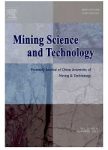Geotechnical behavior of uranium mill tailings from Saskatchewan,Canada
Geotechnical behavior of uranium mill tailings from Saskatchewan,Canada作者机构:Environmental Systems Engineering University of Regina Thurber Engineering Limited Cameco Corporation
出 版 物:《International Journal of Mining Science and Technology》 (矿业科学技术学报(英文版))
年 卷 期:2016年第26卷第3期
页 面:369-375页
核心收录:
学科分类:081902[工学-矿物加工工程] 0819[工学-矿业工程] 08[工学]
基 金:the University of Regina for providing laboratory space and computing facilities Cameco Corporation for material and financial support
主 题:Uranium mill tailings Rheology Settling Segregation
摘 要:This paper investigates the geotechnical behavior of uranium mill tailings from Saskatchewan, *** 4% tailings were well-graded with 29% fines whereas the 5% and 6% tailings were gap-graded with 49% fines. All samples exhibited a negligible strength(0.4 k Pa) up to 60% solids, followed by a rapid increase. The 4% tailings exhibited a lower rate and amount of settlement than 5% and 6% tailings. The kidecreased from 10^(-2)to 10^(-4)m/s with a decrease in eifrom 16 to 4 and a decrease in ef from 8 to 4 such that 4% tailings showed one order of magnitude lower values than the 5% and 6%tailings. The settling potential decreased ten times(50%–5%) for 4% tailings and four times(60%–15%)for 5% and 6% tailings. The effective stress increased from 80 to 260 Pa in the settling tests. The 4%tailings were less prone to segregation when compared with 5% and 6% tailings. The average solids content after settling was 35% for 4% tailings, 40% for 5% tailings and 39% for 6% tailings with a solids content deviation of ±3%, ±8%, ±6%, respectively. All materials were essentially non-segregating at 40%initial solids.



